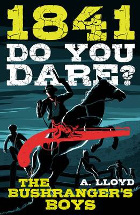The bushranger's boys : 1841 : do you dare? by A. Lloyd

Puffin, 2014. ISBN: 9780143307563.
In 1841, Jem is taken from his home, a slab hut on the sheep run
tended by his father, by the cruel and arrogant station owner,
Captain Ross. Jem's wages will help his father buy the sheep run but
the Captain's word, as Jem quickly learns, is worth little. While
travelling back to the Station, Jem and Ross have their first
encounter with bushranger William Westwood, who has no more love for
the landed gentry and their overseers than Jem, son of a former
convict, has himself.
Life at bustling Ross Vale Station is unfamiliar to Jem, but he
quickly establishes new friends: a rescued puppy, Alfie the cook's
son, whose head is full of heroes and valorous deeds, and Tommy, an
Aboriginal boy whose people, displaced from the land by the arrival
of the squatters, camp along the creek. Alfie tells Jem that Tommy's
people are hungry. The wallabies have gone along with the grass that
is eaten by the stock, and the creek is too churned up by the hooves
of the cattle for fish to breed in it.
When William Westwood saves the pup from drowning in the river where
he has been thrown on the orders of Captain Ross, the boys, in their
gratitude, decide to allow him to hide out in their mountain 'fort'.
Westwood tells them boys something of his life-story and, perhaps
noticing the early signs of a bad case of hero-worship, urges them
not to go the way of the outlaw. Nonetheless, the only way the boys
can obtain food for the bushranger is by stealing. This presents a
moral dilemma: they might be caught and flogged, but if they are not
caught then Alfie's mother, the local Aborigines or other innocent
parties might be accused of the crime. Fear, the desire to stand by
a mate in need, and notions of honesty flash in turn through Jem's
thoughts: mateship wins the day, (or rather, the night.)
The Bushranger's Boys is an easily readable book with enough
action to keep young readers entertained while at the same thing
learning a little of Australia's squatter settlement and the lives
of the men and women who first cleared and farmed the land between
Canberra and the Blue Mountains. The relationship between the two
white boys and Tommy is not fleshed out and is perhaps unlikely.
However, Tommy does allow an opportunity for some classroom research
into the lives of the Ngarigo and the other first people of the
Monaro district. Suitable resources for this purpose include
Josephine Flood's booklet Moth Hunters of the ACT, and an
ABC radio
piece about an Aboriginal shield tree in the Eden region.
Francine Smith